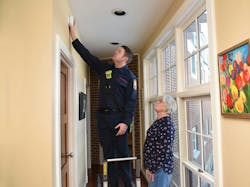Smoke Alarms: Asking the Right Questions Saves Lives
Smoke alarms are key to reducing fire deaths. However, plenty of homes lack the recommended number of smoke alarms.
How do you improve getting smoke alarms into homes? It starts with getting accurate information about smoke alarms. The Johns Hopkins Center for Injury Research and Policy has a simple way to improve it.
What is self-reporting?
Ideally, to identify which homes lack working smoke alarms, we would observe every home and every smoke alarm directly. However, this isn’t feasible.
Self-reporting is a more resource- and time-effective method. Professionals ask the questions, and individuals report the information. It removes the need to enter homes.
Specifically, fire departments often use self-reporting to collect information during community canvassing and smoke alarm programs. With self-reported information, departments provide lifesaving education and installation of smoke alarms to those who are in need. That said, there’s a downside to self-reporting: It can be inaccurate.
Why self-reporting can be problematic?
Fire departments generally accept self-reported smoke alarm status as correct. However, multiple studies found differences between self-reported and observed smoke alarm functionality. The general public tends to over-report when answering commonly used questions to assess smoke alarm status.
Two possible factors lead to over-reporting. First, residents might fail to consider all of the levels of their home. Second, residents might be unaware of the indicators of smoke alarm functionality.
Some indicators of a working smoke alarm include changing the batteries or a test of the alarm in the past six months; the light that’s on the alarm is lit; or the alarm beeps regularly. Another indicator is knowing that the alarm is hardwired.
Inaccurate reporting on smoke alarms limits the services that firefighters can provide. One example is when residents report that their home has enough working smoke alarms, but, in reality, they don’t. In this scenario, firefighters still can offer smoke alarm education, but it might be improperly tailored to a resident. Even worse, firefighters might miss opportunities for smoke alarm installation.
There is a solution. Research that was conducted by the Johns Hopkins Center for Injury Research and Policy found a way to enhance the quality of self-reporting on working smoke alarms.
A simple way to improve self-reporting
The phrasing and quantity of questions can improve self-reporting on smoke alarms. To determine this, the Center compared two smoke alarm status questionnaires: A “Brief Form” and an “Extended Form.”
The Brief Form asked residents whether they: 1) have a working smoke alarm; and 2) have a working smoke alarm on every level of their home.
The Extended Form asked residents to identify the number of levels in their home, including the basement and attic. Then, it prompted residents with a set of questions for each level. They had to report whether a smoke alarm was present, if it was working, and how they knew it was working.
In short, the Extended Form reduced the over-reporting of working smoke alarms. This increased the opportunity to provide tailored education to improve smoke alarm coverage. Prompting residents to think about each floor allowed for better counseling of residents, including how to test an alarm(s) when they are unsure about its status.
An additional way to check smoke alarms
Beyond question phrasing and quantity, it might be beneficial for departments to check smoke alarms. When able, physically hearing an alarm sound can confirm a working smoke alarm.
There are a couple of ways for departments to request to hear a smoke alarm. Ideally, a member of the department could enter a home to test the alarm(s). However, some residents might say all of the alarms are working, or they might ask the department not to enter their home. In these cases, asking residents to sound the alarm while a member of the department is in the doorway is a good alternative.
These steps might add time to canvassing programs, but they also can make programs more accurate and beneficial to residents.
A deeper look into the study
The Center’s study was part of a larger study on child home safety. The study recruited parents of children aged 4–7 who visited the Pediatric Emergency Department at the Johns Hopkins Hospital or the Arkansas Children’s Hospital. Parents were randomized to receive tailored education on either fire safety or child passenger safety behaviors through a computer program.
The study utilized the parents who randomly were assigned to the fire safety education. These parents completed a baseline assessment that included the Brief Form and the Extended Form. The Center summarized their answers to create two comparable variables: any working smoke alarm and a working smoke alarm on every level.
Five hundred fifty four residents completed both forms. When comparing their responses, reporting changed based on the form. The Brief Form had higher self-reporting for both questions.
On the Brief Form, 96 percent of residents reported that they had a working smoke alarm, and 92 percent reported that they had any working smoke alarm on every level. On the Extended Form, only 85 percent reported that they had any working smoke alarm, and 73 percent reported that they had a working smoke alarm on every level.
In total, 111 residents reported that they had a working smoke alarm on every level via the Brief Form but not via the Extended Form. These residents were asked to explain the reason for not having a working smoke alarm on every level. The most-cited reason was believing that they did have one on every level. Some other common reasons were nuisance alarms, such as going off when cooking, and they didn’t believe that they needed one on every level.
How to apply this?
To improve reporting, question phrasing and quantity are clearly important. You must consider the phrasing, order and prompts that are used to strengthen the responses on working smoke alarms.
By first assessing the number of levels that are in a resident’s home, the resident’s answers we were able to be guided. By asking residents to provide a basis for their report of a working smoke alarm, more accurate reporting might have been encouraged.
Physically checking alarms can be an additional step toward accurate reporting. Although more time-consuming than a survey, a department member’s effort to be in a place where he/she can hear an alarm confirms or denies a report of a working smoke alarm.
Two opportunities for using this extended approach are smoke alarm installation programs and educational programs. Both can rely on self-reporting. Smoke alarm installation programs rely on correct reporting as a sign to enter the home. Educational programs need correct information to provide accurate educational materials.
In educational programs, tailored messages can be useful. Another study demonstrated that tailored messages are more effective than generic messages. However, when a person over-reports, tailored messages have limited effect.
Recommendations for programs with self-reporting
The Center calls on all programs that use self-reporting to strengthen their questionnaires. Prompting residents can improve the quality of data that are collected. Use of a format that mimics the Center’s Extended Form is recommended.
For programs that involve smoke alarms, the Center recommends that two main prompts are put in place. First, residents should be asked to state and consider every level of their home. Second, residents should be asked to provide a basis for their report of a working smoke alarm on each level.
The Center’s findings can apply to other safety behaviors, including carbon monoxide alarms, stair gates, seat belt use and bicycle helmet use. Any program can benefit from examining the questions that are asked. Enhancing questionnaires and prompting residents can improve the opportunity for education delivery.
With improved prompting, fire departments can better identify more homes that lack the proper number of working smoke alarms.
Extended Form Smoke Alarm Questions
Let’s think closely about the alarms that are in your home:
- Does your home have a basement?
- Does your home have an attic where someone spends time?
- Other than the basement and the attic, how many other levels are in your home?
Thinking about the basement, attic and other levels of your home other than the first floor:
- If you have a basement, do you have a working smoke alarm in it?
- If you have an attic where someone spends time, do you have a working smoke alarm in it?
- If you have another level in your home other than the first level, do you have a working smoke alarm in it?
- How do you know that the smoke alarm that’s on each of those levels is working?
o Were the batteries changed in the past six months?
o Was the alarm tested in the past six months?
o Is the alarm hardwired?
o Is the light that’s on the alarm lit?
o Does the alarm beep regularly?
o Actually, I’m not sure that my smoke alarm(s) is working.
About the Author

Wendy Shields
Wendy Shields is a senior scientist in the Johns Hopkins Bloomberg School of Public Health’s Department of Health Policy and Management and is a core faculty member at the Johns Hopkins Center for Injury Research and Policy, where she has worked as a research manager for 25 years. She completed her master’s training at the Johns Hopkins School of Public Health after serving as Peace Corps volunteer. Shields’ research interests include the prevention of unintentional injuries, with a focus on home and motor vehicle injuries. She served as the primary investigator of multiple FEMA Fire Prevention and Safety Grants that aimed to improve smoke alarm coverage in homes.

Helena Swaak
Helena Swaak is a research assistant at the Johns Hopkins Center for Injury Research and Policy, where she contributes to the Children’s Housing Assessment for a Safe Environment (CHASE) project. In this role, she assists with protocols for identifying and addressing injury risks in children’s homes. Swaak is an undergraduate student at Johns Hopkins University who is pursuing a dual degree in public health and psychology. Additionally, she is a fellow with Team IMPACT, which is a national nonprofit that fosters inclusion by connecting children who face serious or chronic illnesses with college athletic teams.
